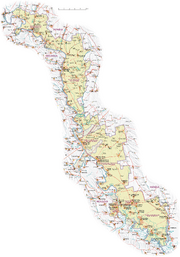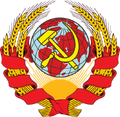| ||||||||
| Capital | Tiraspol | |||||||
| Other Cities | Bender, Dubasari, Ribnita | |||||||
| Language Official |
Moldovan, Russian, Ukrainian | |||||||
| Others | Bulgarian, Romanian | |||||||
| Religion Main |
Eastern Orthodoxy | |||||||
| Others | Catholicism | |||||||
| Demonym | Transnistrian | |||||||
| Legislature | Supreme Soviet | |||||||
| Area | 4,163 km² | |||||||
| Population | 961,875 | |||||||
| Established | September 2, 1990 | |||||||
| Admission | 1992 | |||||||
| Time Zone | MSK (UTC+2) | |||||||
| Summer | MSD (UTC+3) | |||||||
| Abbreviations | SU-NS, TMR | |||||||
Transnistria (Moldovan: Нистрения, Nistrenia; Russian: Приднестровье, Pridnyestrov'ye; Ukrainian: Придністров'я, Prydnistrovya), formally known as the Transnistrian Moldovan Republic, and often abbreviated as the TMR; is a republic of the Soviet Union located in Southeastern Europe. One of the smallest republics of the USSR, Transnistria is mostly comprised of the area east of the Dniester River.
Initially included within the Moldavian SSR, the residence of modern day Transnistria remained loyal to the Soviet Union while the rest of the republic moved toward independence. Shortly after achieving independence, a war over control of the territory broke out between Moldova and the USSR. The conflict would end with a Soviet victory and the annexation of Transnistria into the USSR later in the year.

A detailed map of Transnistria.
The population of Transnistria is roughly populated equally by Romanians, Russians, and Ukrainians. Noted minority groups include Bulgarians, Jews, Roma, and Poles. The vast majority of Transnistrians adhere to the Eastern Orthodoxy Church, with Roman Catholics making about approximately 4% of the population (mostly among the Poles in the northern portions of the republic). Due to its small and narrow area, over 80% the Transnistrian economy is dominated by heavy industry — including the production of energy, textiles, and steel. Transnistria was one of the few republics of the USSR which initiated a large scale privatization of its economy during the 1990s. It is also because of this that Transnistria has begun to brand itself as a new banking center for the USSR and Eastern Europe.
Politically, Transnistria has been something of a "swing state" in Soviet politics since the 1990s. During much of the 1990s, the Communist Party remained dominant within the republic. This changed in the 2000s with support for Alexander Lebed's Democratic Party, and more recently the Liberal Party.
| |||||||||||||||||




